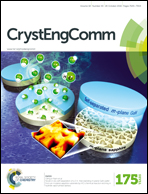Conformational adjustments over synthons of urea and thiourea based assemblies†
Abstract
Conformational adjustments in 1-(n-methylthiazol-2-yl)-3-naphthalen-1-yl-thiourea (n = 4, 5) through carbon–nitrogen bond rotation over an intramolecular hydrogen bonded synthon were established. Isosteric homodimeric hydrogen bonded synthons were analysed in their respective self-assemblies. The corresponding urea derivatives, namely, 1-(n-methylthiazol-2-yl)-3-naphthalen-1-yl-urea (n = 4, 5) also had similar homodimeric sub-assemblies in each of their respective assemblies. However, these two positional isomers of a urea derivative did not show polymorphism, which was observed in the corresponding thiourea counterpart. On the other hand, 1-(5-methylthiazol-2-yl)-3-naphthalen-1-yl-thiourea underwent a facile cyclisation reaction, whereas 1-(5-methylthiazol-2-yl)-3-naphthalen-1-yl-urea formed hydrated salts upon reaction with different inorganic acids. Self-assembly of chloride salt had a bifurcated hydrogen bond between two N–H of the urea moiety with chloride ion, whereas perchlorate salt had a similar bond with the oxygen atom of a water of crystallization, making a difference in the type of heterosynthon. Thus, heterosynthons of these salts were found to be anion dependent. Each salt has a cation differing in conformational adjustments guided by anions. Multi-component hydrated and anhydrous crystals of 1-(5-methylthiazol-2-yl)-3-naphthalen-1-yl-urea with tetrabutylammonium chloride were formed concomitantly. These are examples of anion-guided assemblies of thiazole based compounds containing a neutral host. The different naphthyl group orientations of the heterosynthon resulted in two polymorphic hydrated cocrystals.


 Please wait while we load your content...
Please wait while we load your content...